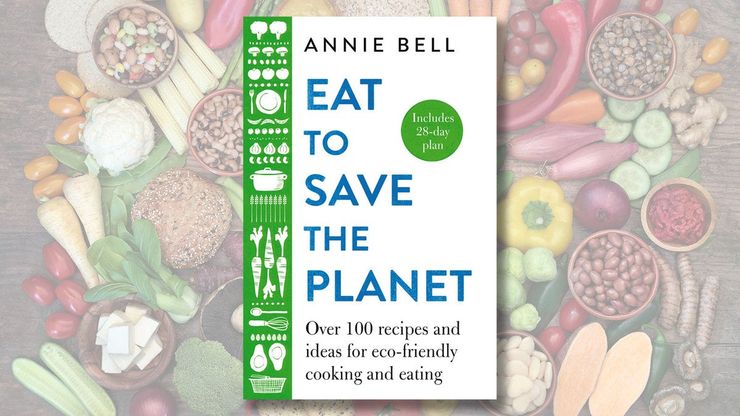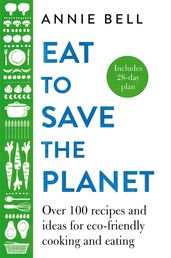Everything you need to know about the Planetary Health Diet
If you want to eat in a more environmentally friendly way, the Planetary Health Diet is an essential guide. But what is the Planetary Health Diet? Here, Annie Bell shares everything you need to know.

We all know we need to make changes to the way we eat if we are to slow the process of climate change. But with so much information out there – from the carbon footprint of your avocado to the environmental impact of your soy milk – it can be difficult to know if we’re making the right choices when it comes to eating an environmentally friendly diet.
That’s where the Planetary Health Diet comes in. This simple diet can be adapted to suit any dietary requirements, and was developed by an international group of scientists with the aim of finding a way to feed the world’s population in a sustainable way. Here Annie Bell, author of Eat to Save the Planet, tells us more about the Planetary Health Diet and the advantages both for the environment and for the health of people around the world. And if you’ve been inspired to eat to save the planet, Annie’s book is full of simple, delicious dishes and a 28 day meal plan to get you started.
What is the Planetary Health Diet?
The Planetary Health Diet offers a solution to feeding the world’s projected population of ten billion a sustainable diet by the year 2050. By combining nutrition with the environment it is a major first. And the diet is incredibly simple. It can be adapted by anyone of any dietary persuasion anywhere in the world. Regardless of whether you are a flexitarian, pescatarian, vegetarian or vegan, whether you live in London, New York or Tokyo. It suggests how much of different food groups you should eat, with maximum limits for animal proteins in particular.
The recommendations are contained within the report Food in the Anthropocene, drawn up by the EAT-Lancet Commission, which involved a group of scientists from sixteen countries around the world, ranging from environmentalists to dieticians.
What are the advantages of the Planetary Health Diet?
If the world’s population continues to eat in the way that they are, the global burden of disease will continue to spiral at the same time as the planet becoming degraded. It is estimated there are over 820 million people globally who don’t have enough to eat. Double that figure, if you also include those people whose diet is lacking in essential vitamins and minerals. And as a result of this, the incidence of obesity, and diseases such as coronary heart disease, stroke and diabetes are all on the up. This links back to the recent pandemic where all of these were underlying risk factors in terms of the severity of the virus. So there is more reason than ever before why we need to address unhealthy diets.
And this lack of nourishment cannot be separated out from the environment when so many of the Earth’s systems have been pushed to their limits. The danger of the world continuing to eat in this way is the risk of failing to meet the UN Sustainable Development Goals (SDGs) and the Paris Agreement. And as the planet becomes degraded this will lead to more malnutrition and the diseases that follow on from that. So it becomes a self-perpetuating cycle. The Planetary Health Diet offers, for the first time ever, a way of eating that is based on a set of globally agreed scientific targets that will protect the environment.
What are the basic principles of the Planetary Health Diet?
The bedrock of the diet is plant foods – whole grains, legumes, nuts, vegetables and fruit. From here it closely tracks the Mediterranean diet, which has long been regarded as the gold standard in nutrition. So unsaturated oils such as extra virgin olive oil rather than animal fats. Just a small amount of animal protein, with the emphasis on fish and poultry, and red meat as an occasional treat. But equally the Planetary Health Diet can be adapted to suit vegans and vegetarians.
Keeping it simple, our targets for major protein sources come down to about one serving of dairy foods per day, and one serving of other animal-sourced protein per day (chicken twice a week, fish twice a week, eggs and red meat once a week). But, in much smaller quantities than usual.
So the recipes in Eat to Save the Planet provide lots of inspiration for treating meat, fish and poultry as a treat, a luxury to be spun out with other plant-based ingredients. I have reformulated some of our favourite traditions – the roasts, pies and burgers that we so love – by combining small quantities of meat, fish and poultry with plant food sources.
All of the recipes are bolstered by a substantial inclusion of whole grains, explored in detail in the chapter Grainology. The rather meagre recommendations for starchy vegetables is another area to be addressed, so the chapter Beyond Potatoes has lots of ideas for sides that will stand in for the usual mashed potatoes, roast potatoes or chips.
Can you eat meat on the Planetary Health Diet?
This diet is designed to cater to the four principle patterns of eating – flexitarian, pescatarian, vegetarian, vegan. The starting point for the Planetary Health Diet was health, without any prejudgments about whether one way of eating was preferable to another. A vegan diet, however, is lacking vitamin B12 as well as running low in other nutrients, and scored lower than other ways of eating. In particular being a pescatarian was found to be marginally more beneficial.
On the environmental side, there are arguments for and against whether to include animal protein in your diet, as the book highlights. The conclusion is that if you prefer to be vegan that is fine, but we can also continue to eat animal proteins with a clear conscience in the reduced quantities recommended if wished, which for most of us will involve eating more plant foods than we do at the moment.
Where should you start with the Planetary Health Diet?
At the back of the book there is a 28 day meal plan to get you started. The Monday through to Sunday diary takes in breakfast through to supper, with suggestions for snacks in between. The Planetary Health Diet is based on an intake of 2500 kcal per day, the average energy needs for a man weighing 70 kg aged 30 years, and a woman weighing 60 kg aged 30 years with a moderate to high level of physical activity. So assuming you are maintaining a healthy weight, there is no need to change the amounts you are eating. Simply tailor these suggestions to your own lifestyle.
The overall dietary pattern is to eat a plant-based diet from breakfast through to supper, including a portion of dairy if wished. So this should include breakfast, lunch, tea and any snacks. The ideal is to draw from all four plant-based food groups, vegetables and fruits, legumes, whole grains and nuts. This can be tailored for vegans by omitting dairy produce. Supper is where different dietary preferences come in to play, depending on whether you are vegan, vegetarian, pescatarian or flexitarian.
As you will be eating whole natural foods throughout the day, including when you are snacking, to ease the potential workload supper is the only time when you need to don an apron and actually cook. Whenever possible though, try to think ahead to the next day’s lunch or day after by cooking extra, especially of veggies and grains.
Eat to Save the Planet
by Annie Bell
Annie Bell, award-winning recipe writer for the Mail on Sunday YOU magazine and a registered nutritionist, delivers this ground-breaking cookbook to help you change your diet and the world for the better. Offering new recipes for your weekly menu from aubergine stuffed with lamb and buckwheat to speedy cauliflower, lentil and watercress risotto, this book provides recipes based on recommendations from the Planetary Health Diet which was commissioned by Lancet-EAT and written by an international group of scientists.



